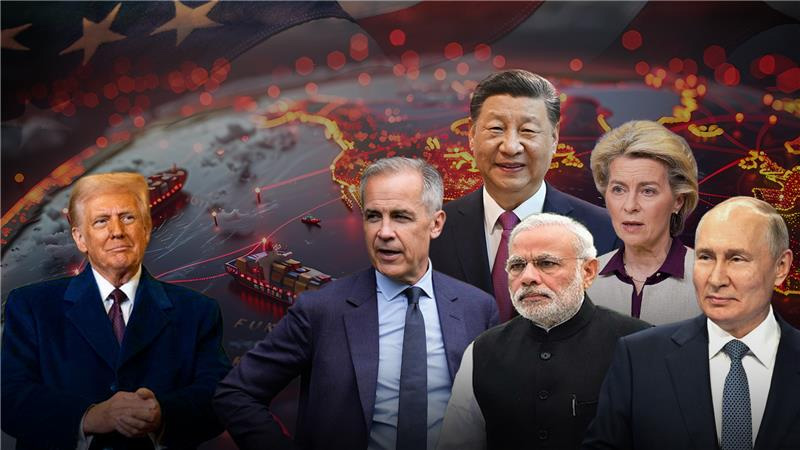There are many reasons to dislike Donald Trump and be suspicious about where he is taking the US and the rest of the world with him. I personally have huge issues with many of the things he says, the ways in which he has no accountability for his words and actions and the people he surrounds himself with. All of them raise many red flags on where he is taking his country and I subscribe to many of the concerns being raised today.
But when I look under the hood of how global trade actually works and the essence of what the US is today as a global economic entity, I am saying to myself that he is very likely to “succeed” in solving several problems that he may not be aware of himself, at least in the short term. We have to ask ourselves – what happens if he is “successful” in the tariff wars?
In a narrow sense, “success” for now is if he gets the rest of the world to come knocking to renegotiate trade deals, something that the US should have managed more judiciously in the past, as other countries do. Also, if he succeeds in affecting the Chinese economy dramatically enough that they too will come asking for a deal. He is very likely to achieve both, at least in the short term, but just enough to give him the licence to wreak even greater damage to the US and the global order. This is what I think we should be really fearing.
But more than that, there is one other dimension he is affecting in an unintended but much more profound way – the US capital market. Many of the reactions against Trump’s really crazy tariffs are based on economic orthodoxy and are not inherently wrong. But they miss the point that the US real advantage over the rest of the world today is not trade, it’s capital. The total global trade in 2024 was about $33 trillion. Global capital flows is infinitely larger. The total global equities market capitalization alone was in the range of $111 trillion in 2023. If you add the funds industry, private capital, derivatives and others, the size of the global capital market is mind boggling larger than trade. The fact that the US accounts for more than 60 percent of global equities alone gives us an idea of its dominance in capital flows as whole, 60-80 percent. The US has the largest wholesale and capital market institutions in the world, bare none.
The relationship between trade and capital is that trade flows merely “informs” capital flows. Trade flows are not an end in themselves. Trade flows are one of the indicators that direct global capital flows. By tinkering with trade, Trump is unintentionally correcting the US capital market. I don’t think he is even aware of this relationship. The US capital market is due for a much needed correction, given all the liquidity that has been pumped in since 2008 and after covid. So we do not need to worry too much about dramatic corrections in capital markets, breathless as they are, because the US economy will come out stronger in the medium term.
The musical chairs that we have seen since 2008 , with the Fed tinkering with interest rates, while making tons of money from buying treasury bonds with money produced from thin air that goes on to feed inflation and productivity, and then handing over the profit to the same treasury that it borrows from, is just a charade that was never going to improve anything. If anything, the shift from investing in short term to long term treasury bonds is creating a much needed discipline in the market.
We should be watching to see if the real impact of the trade tariffs is resulting in the US capital market becoming more disciplined and therefore more potent, despite temporary set backs. Is it rewarding long term investors against short term gains? Analysts who point out to the falling dollar and treasury sell-offs as an indication of the decline of the US economy fail to point out that the countries on the other side of the trade are hurting more. The US has never cared for the impact of its actions on other countries.
The US has very little to offer the rest of the world in terms of trade in goods, except in capital-intensive products. It did have much to offer in terms of trade in services in the 1980s, but even that has gone into decline. But its trade in capital has been growing even more efficient and potent.
Countries rushing to send trade delegations to reprice US tariffs in their favour should be worrying more about preparing their countries for a new global economy based on capital flows. It’s capital, not trade, that has pushed California up to become the world’s fourth largest economy in GDP terms, surpassing Japan. Most countries in the world do not aspire to become a California, because they don’t understand it. It is a highly networked economy, creating value through ruthless innovation while its cities languish in high property prices and homelessness at the same time. But that’s what a capital defined economy looks like.
The rules of capital flows are different from the rules for trade and the US is now setting the world’s standards for this as it did for trade in 1971. After Bretton Woods in 1945, every US economist swore by academic orthodoxy that pegging the dollar against the price of gold was the right thing to do in maintaining price stability and ensuring fiscal accountability.
At Bretton Woods, the US offered its own dollar to be pegged at a fixed rate of $35 and engineered for the dollar to become the reference currency for the rest of the world. The US subsequently actively made its currency available to the rest of the world in the form of loans for post-war reconstruction, but it also became the largest trading nation of the world, as buying from the rest of the world proliferately. So much of the world was being paid in dollars that they also used it to trade with each other. That’s what turned the dollar into a global reserve currency.
But instead of developing any coherent policies to invest in physical and social infrastructure for its own economy, the US did was spend profligately on a whole range of frontier technologies, but also on wars and an active foreign policy. By the late 1960s, the US was no longer able to maintain the peg against the price of gold because its trading partners did not trust the value of the dollar and started competing to buy gold themselves, making it expensive for the US to maintain the peg.
The Nixon shock of decoupling the dollar from the price of gold was criticized by the most prominent of US economists of the day including Milton Friedman, Ron Paul, Robert Mundell and Lewis Lehrman. Everything that Ron Paul and Robert Mundell predicted then about the effect of de-pegging – irresponsible monetary policies and devaluations relative to inflation – came true. Deficit budgets resulted in creating new liquidities in money supply that went to capital markets.
Then in the 1980s, new pressures from its capital markets to ensure corporate profitability caused its corporations to outsource more production to lower cost countries. This rewarded US markets, but at the same time generated wealth for the countries that were on the receiving end of this ruthless desire to ensure corporate profitability. This is where we are today, where the countries that benefited from US largesse are now coming back as equals. Except that the US will keep shifting the agenda yet again.
The US as a capital market plays its cards very transparently and efficiently for the whole world to see. Comapnies are rewarded and punished in an instant on the back of information flows. This ironically is a feature of the US that no other country can even try to emulate. Free information flows is the blood line of capital flows but most countries ameliorate its harsh effects and hide inefficiencies. The US does not even try. It is the harshest country to live in, there are no social safety nets, but it is also the most attractive country to become rich through its capital markets, and that’s what it wants to be.
Some of the tariff negotiations underway today, with countries like India and Indonesia, are linked to US-listed companies like Visa and MasterCard looking for greater access to domestic payments infrastructure. It’s not about reciprocal trade. But today the domestic infrastructures in many countries today have become superior to whatever US companies like Visa, MasterCard or even Paypal can offer, and there is no longer an appetite in much of the world to allow US companies greater access to cream off local profits for their status on NYSE or NASDAQ.
The last time the US elbowed its way into the local economies of many countries in this way was in the 1980s when it forced countries to open up their financial systems to allow US retail, commercial and investment banks as well as fund managers greater access. The US was exporting banking then. Many countries learnt their lessons well, and have stronger financial systems today, resulting in the Citibanks of the world going into retreat after nearly 30 years of global domination. That was he end of one era. The US is now ready to take this to the next level. As a potent global generator of capital, it will be able to use its domination of global capital to pick winners and create losers anywhere in the world.
It’s interesting that Trump says that the tariffs are temporary, in the same way that Nixon said that depegging of the dollar in 1971 was meant to be temporary. The impact in terms of the shape and substance of the global economy are profound and permanent. In the short term, the feedback from the trade tariffs into its capital markets will see a decline in the US markets, and it will appear to have backfired. The US dollar will also be impacted because many of its trading partners do not need to hold on to as much dollars. The US can weather this, because of inefficiencies in its capital markets since the onset of massive quantitative easing, but its other trading partners can’t, because trade is all that they are dependent on.
It’s a story that is repeated many times. Despite the fact that the 2008 banking crisis originated in the US subprime market, the impact on the rest of the world was even worse. No less than Ben Bernanke was able to say in 2010 that the Europeans managed their economic crisis worse than the US when they were not able to manage the sovereign risks in their member states. But everyone forgot that the mortgage crisis originated in the US. It is very likely that the US will again be able to point to internal fallouts in Europe or China, even if these were created by the original US tariffs of 2025, and this too will point to a “success” for Trump.
It does not matter if Trump is thrown out before the next election. We tend to focus on personalities. The US was going to play the tariff game regardless of who was in office. The US as a country has the uncanny ability to throw up a leader who instinctively or otherwise, responds to an idea whose time has run its full course. Its next leader, Republican or Democrat, has the licence of wielding wider powers and scope of interventions, and to be even bolder than Trump was in his time. As a country, it is like a beast that is merely acting out its own transformation, which was from a manufacturer of goods and services into a manufacturer of capital today.
In the process, the periphery will become the mainstream. Two of the nastiest dictators of the 20th century, Hitler and arguably Daniel Francois Malan of South Africa, were leaders of minority parties that eventually became mainstream through economic conditions that escalated in the same way. In both cases, when external capital dried up, the state became the main deployers of capital, which they then used to achieve their sordid social schemes.
The loss of trade flows will destroy many exporting countries. But in five short years, we will all forget that the problems in our respective countries originated from the Trump tariffs of 2025. To say that we are seeing the decline of the US and the rise of another civilization is not going to help any of us, as if the rise of another superpower is the answer we are looking for. What is happening is that the US has shifted the course of geopolitics for the next twenty years, as long as its hold on global capital flows continues to become even more efficient.
The US as a country should have ceased to exist several times in its history – during the Civil War of 1861, after the Great Depression of 1929 and yet again after the depegging in 1971, to name but a few. But it didn’t. At every point, it became an even stronger nation by changing the rules of everyone else and was able to point fingers at other countries for not keeping up with its changing narrative. Now as before, t is changing the rules of its global domination yet again. It’s not trade now, its capital flows that we need to be scrambling to save and something about California should teach us what a capital-defined economy would look like in the future






